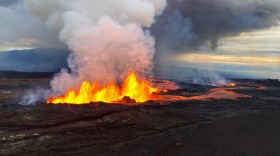-
Researchers Megan Porter and Becky Chong received a grant from the National Science Foundation in 2022 to study biodiversity in Hawaiʻi Island's lava tubes. "We're still finding new species all the time," Porter said.
-
Hawaiʻi needs a circular economy; Filipino textiles and design; Kīlauea update and Maunaloa reflection; Hana hou hiking Maunaloa
-
Scientists say last year's Tonga volcanic eruption produced the fastest underwater currents ever recorded. HPR's Derrick Malama has more in the Pacific News Minute.
-
Kīlauea, one of the most active volcanoes in the world, is erupting after a two-month pause, displaying glowing lava that is a safe distance from people and structures in a national park on the Big Island.
-
Public comment is being sought on the draft environmental review to restore roadways and water lines in Puna, following the 2018 Kīlauea eruption. An estimated $88 million in infrastructure restoration projects are being planned by Hawaiʻi County in partnership with the Federal Emergency Management Agency.
-
Scientists have done further research into a huge volcanic explosion that ripped through part of Tonga early last year. They have found the magnitude was equivalent to the most powerful nuclear device ever detonated by the United States. HPR’s Derrick Malama has more in the Pacific News Minute.
-
It's been just over a year since a massive volcanic explosion rocked the Pacific island of Tonga. The eruption created a huge plume of ash and water that stretched more than halfway to space. HPR's Derrick Malama has more in the Pacific News Minute.
-
The eruption started Sunday night in the Mokuʻāweoweo caldera on the summit of the world’s largest active volcano. At last check, only the lowest fissure on the Northeast slope is currently active. The Conversation’s Russell Subiono talked with USGS geologist Katie Mulliken to get the latest.
-
Maunaloa is erupting for the first time in nearly 40 years. Mayor Mitch Roth and the Red Cross's Matthew Well talk to The Conversation.
-
While Mauna Loa erupted last night for the first time in nearly four decades, researchers are still studying the effects of another volcano that erupted in Tonga earlier this year. It was the largest eruption ever recorded using modern technology. HPR’s Derrick Malama has more in the Pacific News Minute.
Play Live Radio
Next Up:
0:00
0:00
Available On Air Stations









